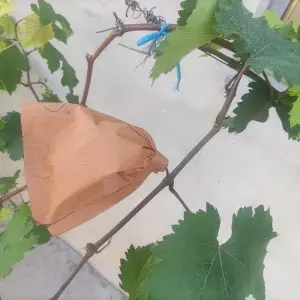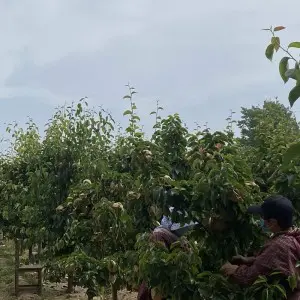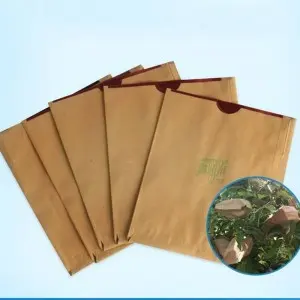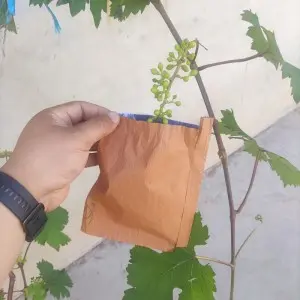Oct . 20, 2025 13:05 Back to list
Fruit Paper Bags - Eco, Breathable, Pollen Block Protection
Field Notes from Hebei: The Quiet Revolution of Orchard Fruit Bagging
Last autumn I walked the rows in Zhao county, listening to growers talk about yield, color, residue limits—the real stuff. The humble fruit paper bags they were using looked simple, but the tech inside them isn’t. This model—officially, “FRUIT PAPER BAGS FOR PREVENTING INSECTS AND PESTICIDE RESIDUES IN ORCHARDS”—comes out of the Caozhuang Development Zone, Fanzhuang Town, Zhao county, Shijiazhuang, Hebei Province. On paper (pun intended), they reduce disease, cut pesticide exposure, and brighten the fruit’s skin tone by enhancing anthocyanin development. In practice, the results are surprisingly consistent.

Why the buzz now?
Two converging trends: stricter MRLs (maximum residue limits) in export markets, and retailers benchmarking cosmetic quality harder than ever. Bagging shifts the game. It’s not just about pest exclusion; it’s about surface finish, reduced wind rub, and safer transport. Many customers say the lot-to-lot consistency improves, which buyers actually notice.

How they’re made (short version)
- Materials: wet‑strength virgin kraft (≈45–60 gsm), food‑grade water-based sizing, optional black inner layer for light management.
- Process: sheet formation → water-resistance sizing → flexographic print → die-cut window/flap → micro‑perforation → QC.
- Testing: grammage (ISO 186), Cobb60 water absorbency (ISO 535), Gurley air permeability (ISO 5636‑5), tensile (ISO 1924‑2), burst (Mullen) for robustness.
- Service life: around 90–150 days on the tree; real-world use may vary with humidity and UV.
- Industries/crops: apples, pears, peaches, mangos, pomegranates—anywhere export specs push for clean peel and low residue.

Technical performance (typical)
The team shared bench numbers from recent lots. I’ll paraphrase—field results always wiggle a bit, to be honest.
| Spec | Typical Value | Notes |
|---|---|---|
| Paper weight | 45–60 gsm | ISO 186 |
| Cobb60 water absorbency | ≤ 35 g/m² | ISO 535 |
| Air permeability | 20–50 s (Gurley) | ISO 5636‑5 |
| Tensile (MD/CD) | ≥ 3.0/1.5 kN/m | ISO 1924‑2 |
| UV shading | ≈85–95% | Helps color development |

Application tips (from the field)
- Timing: bag 20–40 days after fruit set; remove 7–15 days pre‑harvest for final blush.
- Method: dry fruit surface, fold flap snugly; avoid trapping moisture after rain.
- Compliance: materials typically align with GB 4806.8 food-contact requirements and EU 1935/2004 frameworks; ask for lot certificates.

Sizes and customization
You can spec flap style, micro‑perfs, inner black layer, and single‑color branding. For many orchards, fruit paper bags sized 180×250 mm (apple/pear) or 220×300 mm work best.
| Model | Size (mm) | Layers | Notes |
|---|---|---|---|
| FPB-180 | 180×250 | 1–2 | Apple, early-season pear |
| FPB-220 | 220×300 | 2 | Late pear, peach |
| FPB-280 | 280×380 | 2 | Mango/pomegranate |

Vendor snapshot (what buyers compare)
| Vendor | MOQ | Lead Time | Certs | Customization | Indicative Price |
|---|---|---|---|---|---|
| JML (Hebei) | 10k pcs | 10–20 days | GB 4806.8, ISO 9001 | Size/print/perfs | $$ (mid) |
| Vendor A (Zhejiang) | 20k pcs | 15–25 days | ISO 9001 | Size only | $ (low) |
| Importer B (EU) | 5k pcs | Stock/fast | EU 1935/2004 | Branding | $$$ (high) |
Case notes and grower feedback
Hebei apple blocks using fruit paper bags reported ≈30–50% fewer cosmetic defects (wind rub/insect blemish) and measurable reductions in detectable residues at harvest compared with non-bagged controls. One manager told me, “We used fewer sprays late season, and the peel stayed clean after storms.” Storage bruising also trended down, which I didn’t fully expect, but it tracks with less pre‑harvest abrasion.

Compliance and sustainability
For buyers: request DoC to GB 4806.8 and migration testing aligned to EU 1935/2004 (plus FDA 21 CFR 176.170 if exporting to the U.S.). Some lines offer compostable components targeting EN 13432/ASTM D6400; verify lot by lot. As always, fruit paper bags don’t replace good IPM—they just make it easier to meet retailer specs without over‑spraying.
References
- ISO 535: Paper and board — Determination of water absorbency (Cobb method).
- ISO 5636-5: Paper and board — Determination of air permeability (Gurley method).
- ISO 1924-2: Paper and board — Determination of tensile properties.
- GB 4806.8-2016: National Food Safety Standard—Paper and Paperboard Materials and Articles.
- EU Regulation No. 1935/2004 on materials intended to come into contact with food.
- ASTM D6400 / EN 13432: Compostability standards for packaging.
-
Comprehensive Guide to CE Certification Apricot Pollen Health Benefits
NewsNov.24,2025
-
CE Certification Mango Fruit Protection Bags: Enhancing Export Quality & Sustainability
NewsNov.23,2025
-
CE Certification Varieties Suitable for Collecting Apple Pollen – Ensuring Quality & Compliance in Apple Breeding
NewsNov.22,2025
-
Comprehensive Guide to CE Certification Mango Cover Bags – Quality, Standards & Trends
NewsNov.22,2025
-
What You Need to Know About CE Certification Peach Blossom Powder Keto
NewsNov.21,2025
-
CE Certification Pear Pollen Collection Base – Ensuring Quality & Sustainability in Global Horticulture
NewsNov.20,2025